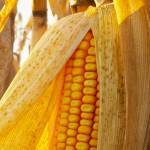Corn Sensitive to Fumonisin Infestation

Horse owners like to concoct homemade mixtures for their charges. Some owners occasionally resort to cutting or diluting a concentrate (textured, pelleted, or extruded feed) with a straight cereal grain such as oats or corn.
When quizzed, most owners will admit that such a feeding regime is less expensive. That’s probably true, in a dollar and- cents sense. But there are disadvantages, namely the delivery of sufficient nutrients. Feeding recommendations are printed on bags and tags for this reason: to ensure horses eat enough of the product to guarantee intake of specified nutrients.
Though cutting feeds is rarely detrimental, Mother Nature has added a sinister twist this year. Imagine this scenario: A backyard horse owner supplements the sweet feed of her few horses with several ears of corn apiece. A neighboring dairy farmer gives her the corn out of kindness, and the horses seem to enjoy gnawing on the cobs.
Within a week to ten days of the first feeding, all of the horses are exhibiting signs indicative of nervous system compromise including aimless wandering, marked incoordination, and a depressed flight response to stimuli that would normally elicit startling or fear. Veterinarians are called, but the condition of the horses seems to worsen. Nothing can be done to save the horses.
These horses were diagnosed with equine leukoencephalomalacia (ELEM), a condition brought about by the ingestion of fumonisins, a family of mycotoxins that often contaminates corn prior to harvesting. Fumonisins are produced by the fungus Fusarium verticillioides, which is widespread in the midwestern and southeastern United States. Kernels become infected in several ways: airborne dissemination of the fungus, insect infiltration, or internal, systemic infection of the corn plant.
Specific weather patterns have proven to be instrumental to the contamination rate of corn. Corn is most susceptible to fumonisin in temperate areas where midseason drought is followed by late-season rains. This is particularly true if corn plant growth is at the “silking” stage, about 55-66 days after emergence from the ground, when the drought occurs.
Drought was common throughout the United Statesin 2005. Not only will corn yields be characteristically low this year due to lack of rainfall, the weather has left some corn sensitive to fumonisin infestation.
Paul Vincelli, plant pathologist at the Universityof Kentucky, found signs of fumonisin-related kernel rot in fields throughout Kentucky. The plant disease might involve individual kernels or clusters of kernels on an ear of corn. Discoloration of kernels is usually the first visible sign, with kernel caps becoming salmon-pink or a light shade of red. Once the signs develop, the pathogen may continue to spread on the ear, knitting a cotton-like growth that might eventually cover the entire ear. Complete coverage is likely to occur if moisture was trapped beneath the husk. Not all infected kernels, however, show signs.
Certain ears of corn, depending upon their position on the stalk, may be more susceptible to fumonisin proliferation than others. Those pointing upright (with silk towards the sky) during heavy rains likely absorb more moisture than those situated in other ways, especially if the husk was damaged in some way, such as by insects or wildlife. Moisture seems to increase the likelihood of disease.
ELEM, also called moldy corn poisoning or blind staggers, is not a novel syndrome among horses. In fact, the disease has been recognized for decades. However, the causative agent— fumonisin—was not determined until the late 1980s. First recognized in South Africa, documented cases of moldy corn poisoning have occurred in several countries: Italy, Australia, Hungary, Mexico, France, Turkey, and of course, the United States. In the United Statesmore than 200 cases of ELEM were diagnosed at veterinary diagnostic laboratories in 11 states in a two-year period, so its prevalence is far-reaching.
As with most instances of toxicosis, the course of ELEM depends largely on intake—how much mycotoxin is consumed and how fast the horse ingests it. Horses generally begin showing clinical signs of the disease two to nine weeks following ingestion.
Neurologic deficiencies are the most telling signs. Subtle indications such as a lack of appetite and depression may preface more severe neurologic signs including progressive incoordination, blindness, circling, and headpressing (resting the forehead against a stationary object such as fence post or a stall front and then leaning into the object). Many horses eventually become recumbent because of worsening ataxia feed. Any feed not consumed by horses should be discarded and muscle tremors. Horses that show neurologic signs typically die from ELEM. In several outbreaks, for example, 65-100% of horses showing clinical signs died. A few horses may show none of the aforementioned disease characteristics but still succumb to the disease.
By the time clinical signs have become apparent, there is little that can be done in the way of treatment. No antidote for the toxin is known.
Interestingly, ELEM cannot be reproduced in other species. Moldy corn responsible for induction of disease in horses did not adversely affect goats, pigs, chickens, mice, rats, guinea pigs, or rabbits.








